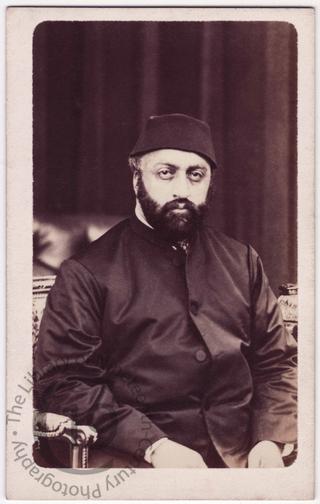
The Sultan of Turkey
A carte-de-visite portrait of Sultan Abdul Aziz (1830-1876), who reigned as the 32nd Ottoman Sultan from 1861 to 1876.
A son of Mahmud II by a slave girl, in 1861 he succeeded his half-brother Abdulmecid. Although the programme of reform begun by his predecessor continued during his reign, especially in the areas of administration, law and education, the tendency of his government was towards autocracy.
A despotic and capricious ruler, he was also an eccentric with a passion for ram-fights and camel-wrestling. During his reign, money borrowed to fund dams and railways was spent on the construction of yet more palaces, most notably the Ciragan, lined on the outside with neo-Gothic windows and pink marble columns like the Doge's Palace in Venice, decorated on the inside in ivory, porphyry and mother-of-pearl. Hated as 'the devourer of the people's substance', he was said to live on hard-boiled eggs, since they were the only food he trusted not to be poisoned.
In the latter part of his reign he was held responsible for the worsening condition of his empire, made manifest in its financial bankruptcy and its internal revolts, most notably in Bulgaria.
Abdul Aziz was deposed on 30 May 1876, and replaced on the throne by his nephew. He was removed with his mother, maids, and immediate family to the Ciragan, where he spent his time reading the Koran. On the morning of 3 June he asked his mother for a pair of scissors to trim his beard, and was later found in a pool of blood, having used them to slash his wrists. Despite a certificate of suicide from eighteen doctors, rumours soon circulated that the suicide was murder.
Photographed by William and Daniel Downey of London and Newcastle during the Sultan's visit to London in July 1867.
Entered at Stationers' Hall on 27 July 1867 (form completed 27 July 1867; registration stamp 30 July 1867).
Code: 125317




